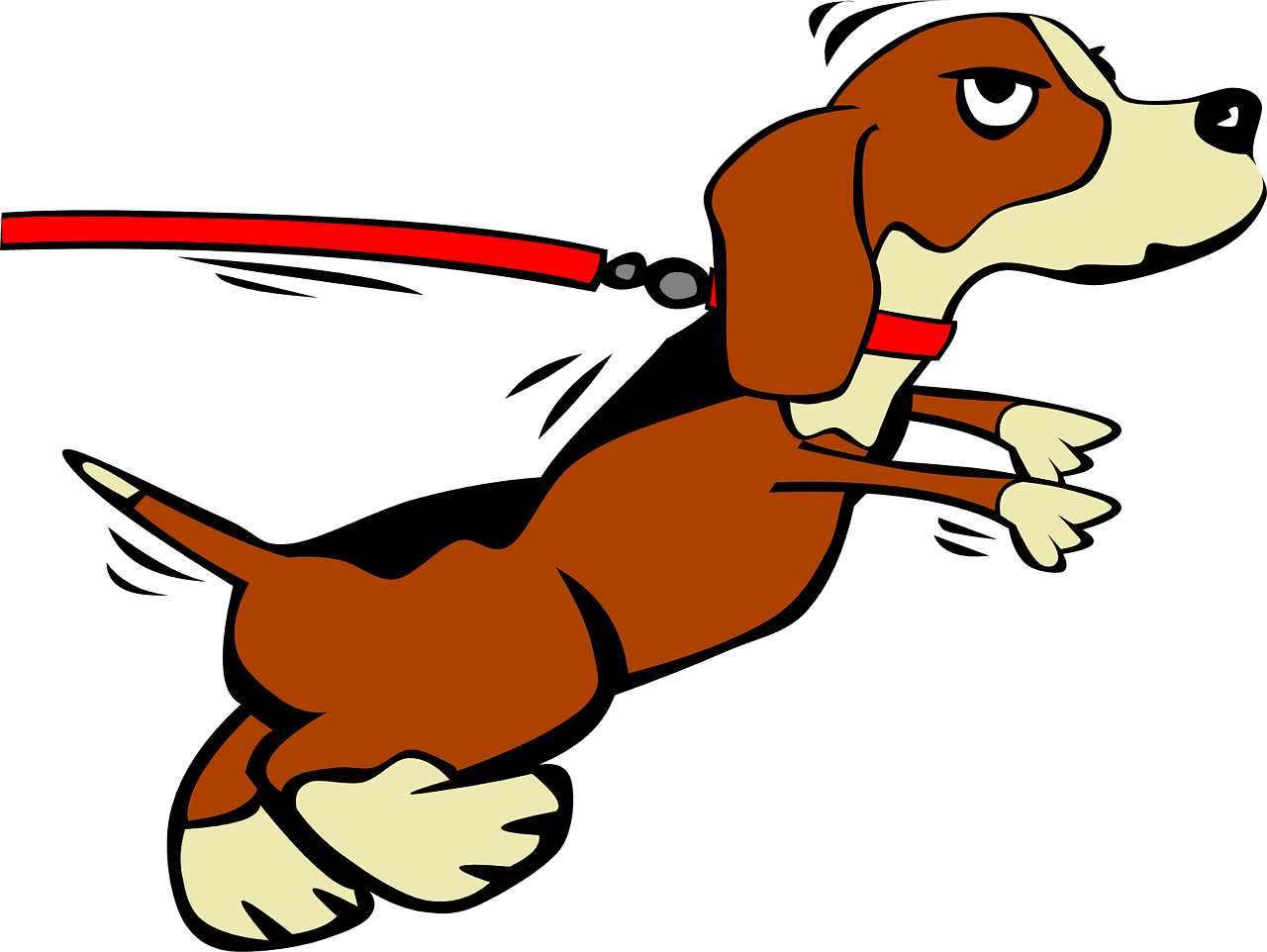If your dog pulls on its leash excessively while you are taking a walk, consider the following:
- Hold the leash in the proper way — looped around the thumb, with the hand close to your belly button
- Use treats from your pocket in order to keep the dog close to you
- Make sure your dog is not under-exercised when taking them out for a walk
- Practice in calm, quiet areas
- Change direction as soon as the dog starts pulling on their leash
How to Stop Our Dog From Pulling on the Leash
Before we delve into the ways of fixing the behavior in question, it is important to mention something.
Choke chains and prong collars are not recommended. They are supposed to fix excessive leash pulling, but they will in no way teach your dog how to behave properly.
Pain is not an effective motivator. Additionally, such leashes might cause injuries, especially if our dog is really energetic.
Instead, let’s have a look at some techniques and positive training that will help us when our dog pulls on the leash, and we have tried everything.
Master Holding the Leash
Developing a good technique of holding the leash is essential to keeping our dog under control.
I recommend looping the leash around our thumb, so it is hanging from our thumb and through our palm. After that, we close our hands over the leash.
Next, we position our hand close to our belly button — this will ensure we have a firm grip on the leash.
Make Effective Use of Treats
While one of our hands is holding the leash, the other must be ready to provide treats at a moment’s notice.
The key is to keep this hand close to the pocket containing the treats. This way, our dog will want to stay close to us, so they can get their treats as quickly as possible.
If we are consistent with that method and use it every day, our dog will learn to walk alongside us in no time.
Make Sure Our Dog Is Getting Their Exercise
As we mentioned, excess energy is one of the main culprits behind leash pulling. For some dogs, just a stroll around the block is not enough.
Imagine how hard it must be for such a dog to remain calm while being taken for a walk in the park when all they want is to exert energy and run.
We must allow our dog to get plenty of exercise before expecting them to walk slowly and not pull the leash.
Practice in Calm, Quiet Areas
Effective dog training cannot be done while in the dog park, for instance. In order to teach our dog proper behavior, we must eliminate all possible distractions.
That is why it is a good idea to take walks in calmer areas.
By doing this, we can practice our leash control and teach our dogs to expect treats if they stand close beside us without worrying about potential triggers.
Taking walks in less populated areas is great if your dog pulls on its leash because of stress or fear.
As we are walking, we should give our dog various commands, like “sit” and “down.” Whenever they perform the activity we requested, we should reward them with a treat.
This will develop into being a calming activity for our dogs whenever they feel under stress.
Once we start training our dog this way, we should gradually increase the stress level of the environment. With persistence, our dog will be able to walk around stress-free.
Don’t Follow the Dog When They Pull
Another effective method we should try out is turning around when our dog starts pulling on their leash.
As soon as we feel tension, we should switch directions. This way, our dogs will realize they are not in the lead and quickly learn to stop this behavior.
We should only let our dog move forward if the leash is in the shape of a “C” or a “J.”
Of course, we should not use excessive strength while changing our direction — our dog will not be trained properly if they feel pain when they do something wrong.
Patience & Persistence
We must not kid ourselves — training our dog to walk properly while on a leash will not happen in a few days.
In addition, different environments will have a different effects on our dog. For example, they might behave while in the park, but go wild when visiting the pet store.
Consistent training and patience are essential if we want our dogs to stop pulling on their leash.
As dog owners, we are aware that one of the hardest things to achieve is to teach our dogs to walk slowly while on a leash.
Speaking from personal experience, I cannot count the times I got frustrated as my dog was dragging me around the park.
I imagine that the whole thing was quite annoying for my dog as well.
Many of my friends also had the same problem — their dog pulls on the leash, and they’ve tried everything in order to stop them, to no avail.
Of course, dogs are not pulling on their leashes just because they want to make us mad.
There are actually many valid reasons for such behavior, and understanding them will help us deal with the problem.
So, if you are tired of those blisters, and want to enjoy a calm walk with your pup, this article is just for you.
We will take a look at the most common causes of excessive leash pulling and outline what can be done in order to fix that problem behavior.
Why Does My Dog Pull on Its Leash?
No, it is not because they have a strong urge to be the pack leader or dominate us in any way. The most common reasons are actually quite simple, and thankfully, quite manageable.
If your dog pulls on the leash and you have tried everything without success, consider the following possible causes:
The Dog Wants to Get to Something
The simplest explanation is most often the correct one. If our dog is pulling on their leash, they probably really want to go somewhere, sniff something, or meet another dog.
The leash just happens to be in the way, but that won’t stop them from reaching their goals. We must pay attention and identify any triggers that make our dog act this way.
Excessive Energy
If our dog is underexercised, they might not be able to restrain themselves while out in the open.
Dogs need to exert energy, and having an open space in front of them will certainly trigger them.
The excess energy will take them over, and in some extreme cases, they might even become uncontrollable.
When this happens, pulling on the leash might end up being the least of our troubles.
We Are Too Slow for Them
Dogs are generally much faster than humans. When we add the excitement from being outdoors, it won’t be a surprise if our dog walks a bit faster than anticipated.
If we fail to keep up with them, they might start pulling on the leash because of our slow speed. They might also be encouraging us to pick up the pace.
The Dog Is Just Excited
In most cases, going out for a walk is by far the most exciting part of a dog’s day. Their excitement prevents them from thinking clearly or following commands.
This might cause them to go wild and fast, resulting in blisters on our poor fingers.
Fear or Anxiety
Certain environments can make our dog feel threatened, stressed out, and anxious.
They might want to run away, or look for a sense of security in the pressure of the leash around their necks.
If our dog pulls on its leash because of fear, we must immediately remove them from the place/situation that caused it.
So, Our Dog Pulls on the Leash. Have We Tried Everything?
The paragraphs above show that excessive leash pulling might have a lot of causes. It is up to us to define what the problem is and then work towards fixing it.
Whether it is just excitement and too much energy, or anxiety and stress — we must set a training procedure.
As we already mentioned, the most important thing is to be persistent. We must not get frustrated or punish our dog for behavior that has a perfectly logical explanation.
Above all, we must not resort to measures such as using prong collars or choke chains.
Learning to walk properly while on the leash is also a challenge for the dog. We must acknowledge their attempts and reward them properly!
I hope you found this article useful, and you now know what steps to take if your dog pulls on its leash excessively.
For more interesting articles about dog behavior, feel free to check out the rest of my blog. See you at the next one!


